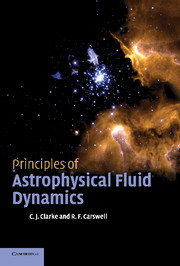Book contents
- Frontmatter
- Contents
- Preface
- 1 Introduction to concepts
- 2 The fluid equations
- 3 Gravitation
- 4 The energy equation
- 5 Hydrostatic equilibrium
- 6 Propagation of sound waves
- 7 Supersonic flows
- 8 Blast waves
- 9 Bernoulli's equation
- 10 Fluid instabilities
- 11 Viscous flows
- 12 Accretion discs in astrophysics
- 13 Plasmas
- Appendix Equations in curvilinear coordinates
- Exercises
- Books for background and further reading
- Index
12 - Accretion discs in astrophysics
Published online by Cambridge University Press: 05 June 2012
- Frontmatter
- Contents
- Preface
- 1 Introduction to concepts
- 2 The fluid equations
- 3 Gravitation
- 4 The energy equation
- 5 Hydrostatic equilibrium
- 6 Propagation of sound waves
- 7 Supersonic flows
- 8 Blast waves
- 9 Bernoulli's equation
- 10 Fluid instabilities
- 11 Viscous flows
- 12 Accretion discs in astrophysics
- 13 Plasmas
- Appendix Equations in curvilinear coordinates
- Exercises
- Books for background and further reading
- Index
Summary
By far the most important application of the Navier–Stokes equations in astrophysics is to the case of circular shear flows, also known (for reasons that will become obvious once we have derived their properties) as accretion discs.
Such flows are encountered in many astronomical environments where gas is in nearly circular orbit around a massive central object. The scales of these flows vary immensely according to the nature of the central objects involved, which range from planets to stars to supermassive black holes. Figure 12.1 shows an example of what is believed to be an accretion disc around a black hole at the centre of a galaxy. Although, as we shall see, there are many qualitative aspects of these flows that are similar in all cases, the manner in which such rotating shear flows are created differs according to the type of astronomical system involved. For example, in the case of the primordial solar nebula, from which the planets in our Solar System were formed, the flow inherited its angular momentum from the slowly rotating cloud core which collapsed to form the Solar System. In the case of discs around supermassive black holes in the cores of galaxies, the origin of the gas orbiting the hole is not entirely understood, but virtually any explanation one could think of – be it gas shed from stars in the inner galaxy, or debris from stars tidally shredded by the black hole, or the swallowing of a small satellite galaxy – would involve gas that possessed significant angular momentum with respect to the central black hole.
- Type
- Chapter
- Information
- Principles of Astrophysical Fluid Dynamics , pp. 163 - 178Publisher: Cambridge University PressPrint publication year: 2007



